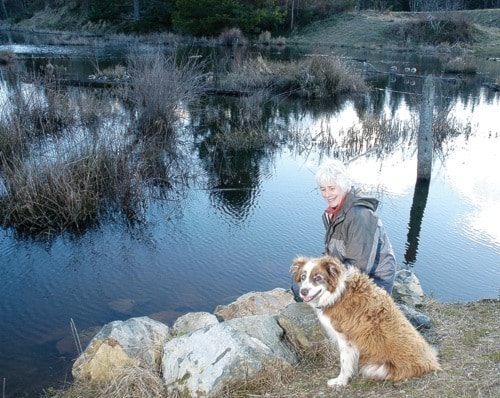A walk on New Year’s Eve has turned into a two-month environmental investigation for a Nanaimo resident.
Sally Ramsay was walking her dog, Reggie, on the shore of a wetland near a new housing development in Linley Valley when she noticed a thick, black sludge gushing from a submerged storm sewer pipe after a heavy rainfall.
Concerned about the potential consequence the mysterious substance would have on the beavers, ducks, geese, deer, eagles and other creatures that live in the wetland, Ramsay jarred some samples and made a few phone calls to determine the origin of the pollution.
“It wasn’t just a sheen, it was thick black ribbons of oil that were clearly coming from the pipe, which I learned later is the storm run-off system from the nearby development,” said Ramsay. “After some digging, I became aware that it’s standard practice across the province to allow unfiltered run-off pipes to drain directly into what are considered environmentally sensitive areas. I’m appalled to think what’s allowed to flow into a wildlife pond.”
She contacted city officials in early January, who visited the site.
The oil persists now, having embedded itself in the mud along the shoreline and amongst the vegetation. As recently as Feb. 4, heavy rainfall flushed more oil out into the wetland.
First thoughts were a nearby contractor’s vehicle was leaking oil, but Ramsay said she thinks the amount of oil suggests something else, possibly contaminated land that is being disturbed by the development or negligent dumping.
On Valentine’s Day, officials worked to contain the slick with booms and absorbent pads in an effort to contain the spread of the oil, but the slick has been blown to the other side of the wetland and into an adjacent pond.
Alex Grant, an environmental emergency response officer with the Ministry of Environment, visited the site Feb. 18, but wasn’t permitted to comment on record.
Instead, a ministry spokesman responded with an e-mail that said, “The City of Nanaimo is leading the response and investigation into sediment with an oily sheen in the discharge from the storm sewer at a property in the Rutherford area. The Ministry of Environment visited the site with a city representative and two local residents earlier this week to review the situation and is satisfied with the steps being taken by the local government.”
The response added that it is too early to determine the source of the oil and whether remediation is necessary.
Nanaimo no longer employs an environmental officer capable of monitoring development to ensure developers are adhering to environmental standards.
At a recent council meeting, it was acknowledged that a provincial environment officer had visited the development, which has been ongoing for several years, “once, or maybe twice.”
Council is, however, undertaking a three-month process that will review its riparian set-back policy led by the city’s Advisory Committee on Environmental Sustainability in consultation with the provincial Ministry of Environment and federal Department of Fisheries and Oceans. That process could result in having a municipal environmental assessment officer back on payroll.
Ramsay said she feels if it is standard procedure to allow storm drainage into environmentally sensitive areas – another pipe drains storm run-off directly into the Nanaimo Boat Basin – then outflow pipes should be equipped with filters to prevent toxins from entering the water.
The city’s public works department, however, says filters are not a practical solution because they would result in constant maintenance and if clogged with sediment, could cause overland flood hazards and damage property.
Dean Robinson, the city’s general waste water foreman, said every one of the city’s 11,000 catch basins has a silt trap installed that are cleaned out once a year by his crews. Sometimes, he says, unwanted pollutants enter the system and flow into wetland and streams, eventually entering the ocean if not cleaned up.
“It’s not a perfect world, even though sometimes we’d like it to be. When we are informed of something like an oil spill it immediately becomes our No. 1 priority and we’re on it immediately,” said Robinson. “But the public has to be on board because we can’t be everywhere. In this case, the process worked because we were notified and we responded. Nobody knows a neighbourhood better than the people who live there to say what is normal and what is not normal.”
Robinson said public works gets several calls a year by people concerned with pollutants in local waterways, an increasing trend that he says he welcomes.
But tracking down the source of a spill requires examining a complicated drainage system through maps and, ultimately, scent.
“We literally chase the thing with our noses and try to find the source,” said Robinson. “Sometimes you’re successful, sometimes you’re not. It’s not a matter of not having the motivation.”
Ramsay, a retired teacher, said she remembers two decades ago when north end development was underway, storm sewers with concrete catch basins replaced viable coho salmon spawning streams. At around the same time, she took her Dufferin Elementary School students out to mark storm drains with a fish symbol as part of the Salmonid Enhancement Program to remind people not to dump toxins into the sewer system.
“I was pretty sure this would not be allowed now,” she said. “I thought attitudes had changed. I think we need to make everyone once again aware of the importance of keeping our water courses clean and viable ... and perhaps by making builders more aware and responsible for cleanup when accidents occur.”
To report a spill in a local water course, phone 250-758-5222. The line is monitored 24 hours a day.
